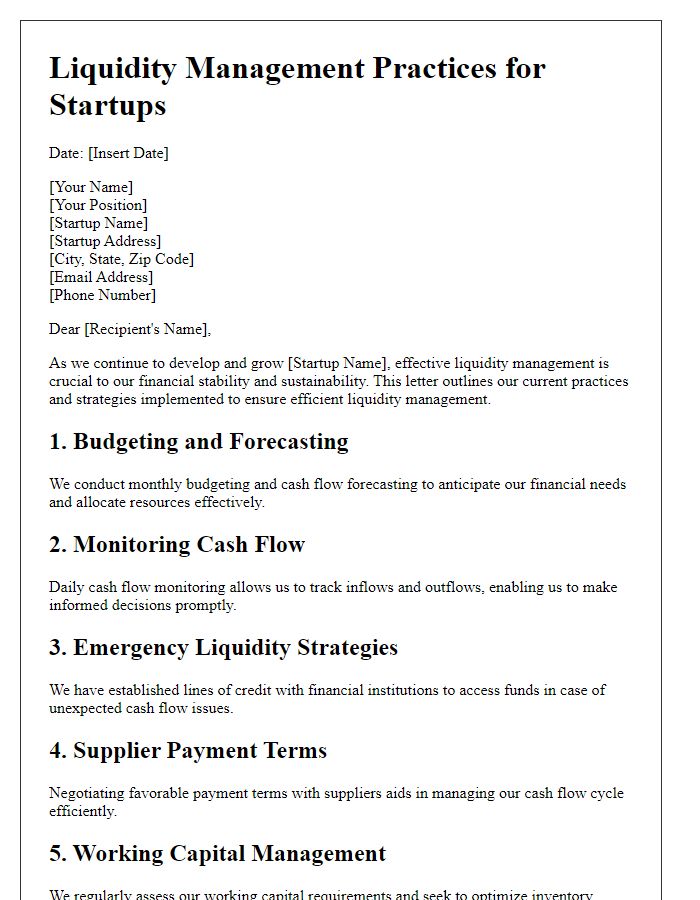Are you looking to enhance your financial strategy with effective liquidity management techniques? Understanding how to maintain optimal liquidity is crucial for both long-term stability and short-term operational efficiency. In this article, we'll explore various strategies that can help you manage cash flow, optimize working capital, and reduce financial risk. So, let's dive in and discover how these techniques can benefit your financial health!

Clear Objective Statement
Liquidity management techniques focus on maintaining sufficient cash flow to meet operational needs. Effective strategies include cash forecasting, which entails analyzing historical data to predict future cash requirements, and optimizing the cash conversion cycle, minimizing the time taken from inventory purchase to cash collection. Implementing a robust system for monitoring cash balances across different accounts enables businesses to identify surplus funds that can be invested or used for debt repayment. The establishment of credit lines with financial institutions ensures quick access to cash during unexpected fluctuations. Lastly, employing techniques like staggered debt maturities can prevent liquidity crises, allowing organizations to navigate financial pressures effectively while ensuring timely obligations are met.
Detailed Cash Flow Forecasting
Detailed cash flow forecasting is a crucial liquidity management technique employed by businesses to anticipate future cash inflows and outflows. This forecasting process often involves analyzing historical data from financial statements, such as income statements and balance sheets, to project future revenues and expenses accurately. Businesses utilize software tools, like QuickBooks or Excel, to create cash flow projections over specific periods (monthly, quarterly), allowing them to identify potential cash shortfalls or surpluses. Seasonal variations in revenue, such as holiday sales spikes or summer slowdowns, can heavily influence these forecasts. Additionally, including components like accounts receivable collections and payable schedules enhances accuracy. This granular approach enables decision-makers to manage working capital more effectively, ensuring that sufficient liquidity is available to meet obligations like payroll and supplier payments, thus minimizing the risk of financial distress.
Strategies for Working Capital Optimization
Liquidity management plays a crucial role in ensuring the health of a business's financial performance. Effective strategies for working capital optimization involve several practices, such as maintaining optimal inventory levels, which can enhance cash flow by preventing overstocking or stockouts. Implementing a robust accounts receivable management process allows businesses to reduce days sales outstanding (DSO) significantly, improving liquidity as cash is collected promptly. Employing just-in-time production techniques minimizes excess inventory and aligns production closely with sales demand, further boosting cash efficiency. Establishing strong relationships with suppliers for favorable payment terms can extend accounts payable periods, allowing businesses to retain cash longer while still maintaining good supplier relations. Businesses may also consider utilizing financial instruments, such as lines of credit or short-term financing solutions, to cover any immediate cash flow gaps effectively, ensuring they have readily available funds to meet operational needs.
Risk Management Practices
Effective liquidity management techniques are essential for organizations aiming to maintain operational stability during financial fluctuations. One key practice involves establishing a robust cash flow forecasting system that utilizes historical data to predict future cash requirements accurately. This methodology is critical for identifying potential shortfalls and surpluses, particularly in industries such as retail or manufacturing, where revenue can be seasonal. Another technique is the use of liquidity ratios, such as the current ratio or quick ratio, which enable businesses to assess their capability to meet short-term obligations. Moreover, maintaining an adequate line of credit with financial institutions, such as banks or credit unions, ensures access to necessary funds during periods of unexpected expenses or revenue delays. Additionally, diversifying funding sources, including trade credit or financing options, can enhance liquidity resilience against market changes. Engaging in stress testing scenarios, simulating economic downturns or operational disruptions, further helps organizations prepare by evaluating the impact on cash flow and determining strategic responses to mitigate risks.
Reporting and Compliance Procedures
Effective liquidity management techniques are essential for financial institutions to maintain solvency and meet obligations. Key procedures include daily cash flow forecasting, which ensures adequate liquidity to handle expected outflows. Periodic stress testing simulates various market scenarios (such as economic downturns or sudden withdrawals) to assess liquidity positions. Compliance with regulatory frameworks like Basel III mandates minimum liquidity coverage ratios (LCR) and net stable funding ratios (NSFR), enhancing resilience against financial shocks. Additionally, robust reporting systems should track liquidity metrics, such as the cash conversion cycle and surplus liquidity as a percentage of total assets, allowing timely adjustments in strategy. Regular audits ensure adherence to these protocols, reinforcing transparency and accountability in liquidity management practices.
Letter Template For Liquidity Management Techniques Samples
Letter template of liquidity management guidelines for nonprofit organizations

Letter template of liquidity management recommendations for investment firms

Letter template of liquidity management policies for financial institutions

Letter template of liquidity management frameworks for government agencies

Letter template of liquidity management approaches for real estate investments

Letter template of liquidity management tools for manufacturing companies








Comments